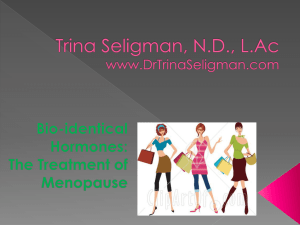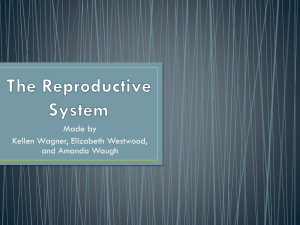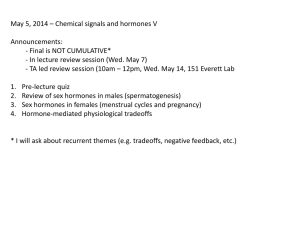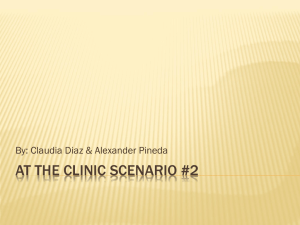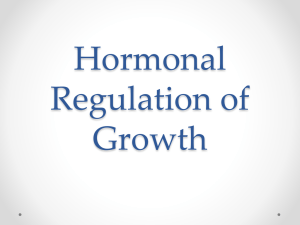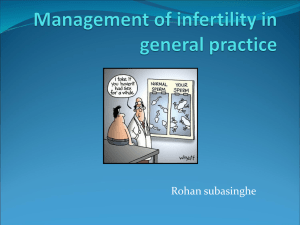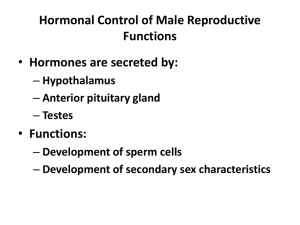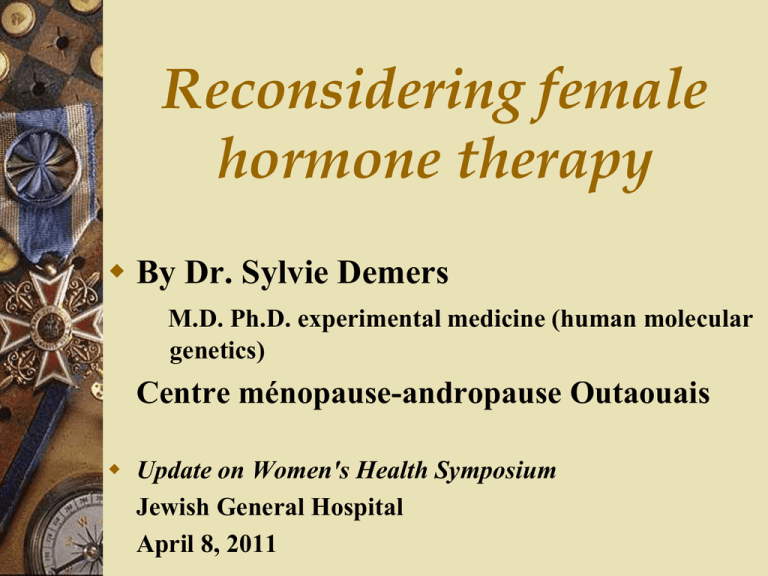
Reconsidering female
hormone therapy
By Dr. Sylvie Demers
M.D. Ph.D. experimental medicine (human molecular
genetics)
Centre ménopause-andropause Outaouais
Update on Women's Health Symposium
Jewish General Hospital
April 8, 2011
Introduction
Controversy breeds science
Physicians must be better trained with regard to female hormone
therapy so that women cease suffering and being mistreated.
Female hormone therapy = controversy!
– Continuous conflicting messages are being conveyed.
– We get confused!
It is time for real debates:
– Why do female hormones, namely estrogens, have a
reputation of being dangerous, or even carcinogenic?
– This sends a negative message to women because estrogens
truly the essence of femininity.
• Incidentally, female hormones are the only human
hormones that are disregarded. This disregard has great
implications on the well-being, health and dignity of
women.
This conference is made
possible thanks to an
unrestricted grant from
Merck Canada Inc.
The contents of this
presentation is free from
outside influence and is
entirely my own scientific
point of view.
Dr. Sylvie Demers
What is menopause?
Natural menopause is caused by a radical
reduction of hormones produced by the ovaries,
and in particular:
17 β-estradiol
Progesterone
Testosterone
Clinically, menopause results from a cessation of
uterine bleeding during a period of 12
consecutive months.
Genetics
of men and women
More than 99.9% of the human gene pool is not linked to
gender.
The main biological difference between men and women
relates to sex hormones.
And we have the same sex hormones (17 β-estradiol
(principle estrogen), progesterone and testosterone)!
The main difference between genders is the levels of
these hormones and the relationship between them.
When I mention female hormones,
I am referring to 17 β-estradiol and progesterone.
1st Objective:
Describe the fundamental
roles of female hormones on
cardiovascular, skeletal,
cerebral and endocrine
health.
FEMALE HORMONES
At least 153 different genes react to estrogens and 150
genes react to progesterone. This, in itself, is phenomenal
and strongly suggests that female hormones encompass a
vast array of functions. (Laganière J. et al. (2005) Proceedings of the National Academy of
Sciences, Vol. 102, p. 11651-11656; Leo J.C.L. et al.(2005) International Journal of Cancer, Vol. 117, p. 561-568.)
Female hormones have an effect on just about every part
of the human body, which explains the wide range of
symptoms (insomnia, anxiety, depression, hot flashes,
muscle aches, joint pain, etc.) and signs (osteoporosis,
heart disease, weight gain, generalized dryness, etc.) that
women may experience when their female hormone
levels drop.
The roles of 17 β-estradiol
According to Dr. Robert Greene,
American gynecologist (Perfect Balance (2005) Clarkson
Potter/Publishers New York, 350 p.)
– Estradiol has more functions in the human body
than any other hormone, a number estimated at
more than 300.
Cardiovascular Health
(References in Chapter 3: Hormones au féminin: Repensez votre santé (2008-2009) Éditions de l'Homme. 259 p.)
Cardiovascular diseases: ~ 31% of deaths among women
Breast cancer: ~ 2% of deaths
Let's be logical!
Before menopause, women are less at risk of suffering from
cardiovascular diseases (including cerebrovascular accidents)
than men of the same age. At menopause, the risk gradually
increases, so that by the age of 75 years, women are equally at
risk as men.
Before the publication of the WHI study, research suggested an
approximate reduction of 40 to 50% in the risk of cardiovascular
diseases due to female hormone therapy. (As seen in Belchetz P. E. (1994) The New
England Journal of Medecine. Vol. 330, p. 1062-1071.)
Women who have had their ovaries removed before the age of 45
years (not treated with estrogens) are much more at risk of
cardiovascular diseases (Rocca W. A. et al. (2006) Lancet Oncology.Vol. 7, p. 821-828.), as
well as menopausal women who have had their ovaries removed
before the age of 65 years. (Parker W.H. et al. (2007) Clinical Obstetrics and Gynecology.
Vol. 50, p. 354-361.)
WISE study: Hypoestrogenism – defined by a mean level of
estradiol lower than 184 pmol/L – would be an important risk of
atherosclerosis (depicted by angiography) among premenopausal
women. (Merz B. et al. (2003) Journal of the American College of Cardiology. Vol. 41, p. 413-419.)
Study conducted on castrated female monkeys: the administration
of 17 β-estradiol is a powerful protective factor against
atherosclerosis. (References: P. 60 in Hormones au féminin: Repensez votre santé (2008-2009) Éditions de
l'Homme. 259 p.)
Menopausal women: oral administration of 17 β-estradiol (1
mg/day) is a protective factor against atherosclerosis. (Hodis H. N. et al.
(2001) Annals of Internal Medicine. Vol. 135, p. 939-953.)
Among the protective properties of 17 β-estradiol:
•
•
•
•
•
•
Improvement of lipid panel
Reduction of arterial blood pressure
Prevention of vasospasms in the arteries
Protection of the arterial endothelium
Improvement in cardiac function
Anti-inflammatory properties (key role in the prevention of many diseases)
SKELETAL HEALTH
(References in Chapter 5: Hormones au féminin: Repensez votre santé (2008-2009) Éditions de l'Homme. 259 p.)
Menopausal osteoporosis, by far the main cause
of osteoporosis among women, is primarily
attributed to:
– A deficiency of female hormones (and not to a
deficiency of calcium or vitamin D).
• For example, the decline of estradiol levels results in calcium
being leached out of the bones.
Did you know that…
According to an American study: (Parker W.H. et al. (2007) Clinical
Obstetrics and Gynecology. Vol. 50, p. 354-361.)
– Bilateral prophylactic oophorectomy (most commonly to prevent
ovarian cancer)
performed on menopausal women, who were not
taking hormone therapy, increase their mortality risk. The
earlier this procedure is performed on women, the higher their
risk of mortality.
– Even after the age of 65 years, oophorectomy (without hormone
therapy) increases mortality following a hip fracture.
– For example, among 10,000 women who underwent a bilateral
prophylactic oophorectomy between the ages of 50 an 54 years:
• 26 to 30 years later (80 years of age):
– Decrease of 47 deaths due to ovarian cancer
– Increase of 838 deaths due to coronary heart disease
– Increase of 158 deaths due to hip fractures
CEREBRAL HEALTH
(References in Chapter 4: Hormones au féminin: Repensez votre santé (2008-2009) Éditions de l'Homme. 259 p.)
17 β-estradiol :
Increases the synthesis of different neurotransmitters
Is a natural antidepressant
Improves memory
Promotes better sleep
Exerts neuroprotective effects through various
properties
ENDOCRINE HEALTH
(References in Chapters 6 and 9: Hormones au féminin: Repensez votre santé (2008-2009) Éditions de l'Homme. 259 p.)
Prevention of type 2 diabetes
– 17 β-estradiol increases both the secretion
and the elimination of insulin
• Consequence: decreased level of basal insulin
•
(Cagnacci A. et al. (1992) Journal of Clinical Endocrinology & Metabolism, vol. 74, p. 1396-1400;
Cagnacci A. et al. (1997) Maturitas. vol 28, p. 163-167.)
An increased level of basal insulin is associated
with many health problems such as
cardiovascular diseases, breast cancer,
endometrial cancer and colorectal cancer.
Roles of progesterone
(References in Chapters 3 to 7: Hormones au féminin: Repensez votre santé (2008-2009) Éditions de l'Homme. 259 p.)
CARDIOVASCULAR
HEALTH
(References in Chapter 3: Hormones au féminin: Repensez votre santé (2008-2009) Éditions de l'Homme. 259 p.)
Diuretic and antihypertensive properties
– 200 mg of micronized progesterone equals to a dose
of spironolactone varying between 25 and 50 mg
Decrease of benign heart palpitations
Decrease of vascular hyper-reactivity
– Possible role in the prevention of coronary
CEREBRAL HEALTH
(References in Chapter 4: Hormones au féminin: Repensez votre santé (2008-2009) Éditions de l'Homme. 259 p.)
Anxiolytic and calming properties
Antiepileptic properties
Multiple beneficial effects on the central and peripheral nervous
system
– Neuroprotective and trophic effects for neurons and glial cells
– Key role in the synthesis of myelin sheath
– Decrease of cerebral oedema and foster regeneration of nerve fibres following
trauma
Promotes better sleep
– Many beneficial effects of progesterone are due to its transformation into
allopregnanolone.
• Allopregnanolone binds itself to GABAA receptors in the brain which results in the
increase of GABA action. GABA is the key inhibitory neural transmitter of the
central nervous system and acts, in a way, as our own natural anxiolytic.
• Micronized progesterone (Prometrium®) increases the duration of deep sleep (in
men as well as women).
– Estrogens also play an important role in the quality of sleep (e.g., regulating
of melatonin). Furthermore, bioidentical female hormone therapy in
adequate doses can renormalise a high cortisol level (a relatively frequent
occurrence in premenopause/menopause).
Other roles of progesterone
(References in Chapters 3 to 7: Hormones au féminin: Repensez votre santé (2008-2009) Éditions de l'Homme. 259 p.)
Beneficial effect on skeletal system
– Possible role in bone formation
Some reduction of hot flashes
Possible protective effect (with the
administration of estradiol in adequate doses)
against colorectal cancer and endometrial
cancer, and in my opinion, against ovarian
cancer and breast cancer.
Antioxidant properties
2nd Objective:
Reveal the advantages of
bioidentical female
hormone therapy versus
those of non-bioidentical
hormone therapy
What are bioidentical female
hormones?
They are composed of transdermal 17 βestradiol and progesterone.
They are made from sterol analogues present
found in many varieties of plants, primarily
the soybean.
These hormones are identical to hormones
produced by the ovaries (same chemical
structure).
Lack of media coverage
concerning the benefits of
bioidentical female hormones!
The majority of laboratory studies regarding female
hormone therapy were conducted using bioidentical
female hormones.
Many clinical studies have been conducted among
women.
Surprisingly, the results of those numerous studies,
which are conducted by many university research
groups in various countries and published in
reputable research journals, rarely get media
coverage.
Why is this so?
Bioidentical estrogens
1) Estrogel®
2) Estradot®
3) Climara®
4) Estraderm®
5) Sandoz estradiol dermPr
6) Oesclim®
gel
patch
patch
patch
patch
patch
17 β-estradiol
17 β-estradiol
17 β-estradiol
17 β-estradiol
17 β-estradiol
17 β-estradiol
7) Estrace®*
oral tablet
17 β-estradiol
8) Tri-Est cream**
cream
estriol(80%)/est/est
9) Bi-Est cream**
cream
estriol(80%)/estrad.
*Estrace® should not be considered due to the way it is administered. Estrogens administered orally may
increase the levels of triglycerides and C-reactive protein, as well as the synthesis of certain coagulation factors.
Furthermore, Estrace® transforms itself into estrone during the digestion process.
**I do not recommend these creams (prepared by compounding pharmacists) because of their non physiological
estrogenic composition, their low absorption rate in the bloodstream, as well as the lack of quality control.
Progesterone
1) Prometrium®
administered orally
2) Crinone®*
3) Suppository**
4) Cream**
administered vaginally (gel)
administered vaginally (cream)
administered transdermally
* I do not know the absorption level into the bloodstream of Crinone®. It is also important to
know that Crinone® is very expensive.
**I do not recommend the use of the progesterone creams because they are typically not well
absorbed into the bloodstream, and furthermore, due to the lack of quality control.
A brief overview
of the WHI study
Administering a dosage of 0.625 mg of CEE and 2.5 mg of MPA among
women between the average age of 63 years (start) and 69 years (end)
caused:
CEE (conjugated equine estrogens, e.g., Premarin®) to be associated
with an increased risk of thromboembolism.
– However, it is important to recognize that CEE were also associated
with a decreased risk in fractures, breast cancer, colorectal cancer,
infarctions and death. (The Women's Health Initiative Steering Committee. (2004) The Journal of
the American Medical Association.Vol. 291, p. 1701-1712.)
MPA (medroxyprogesterone acetate, e.g., Provera®) to be associated
with an increased risk of infarctions, breast cancer, as well as lung
cancer. (Writing Group for the Women's Health Initiative Investigators (2002) The Journal of the American Medical
Association. Vol. 288, p. 321-333; Mastorakos G. et al. (2006) New York Academy of Sciences. Vol. 1092, p. 331-340;
Chlebowski R. T. et al. (2009) Lancet. Vol. 374, p. 1243-1251.)
– MPA is suspected of being harmful in many ways, including having
carcinogenic properties.
When administered before the age of 60 years, CEE with and
without MPA offer greater benefits than risks and are associated with
a statistically significant decrease in deaths by 30%. Benefits are
attributable to estrogens. (The Women's Health Initiative Steering Committee (2004) The Journal of the
American Medical Association. Vol. 291, p. 1701-1712.)
CEE and 17 β-estradiol
Do not mistake one for the
other!
CEE (conjugated equine estrogens) are estrogenic
compounds isolated from pregnant mare's urine and
are foreign to a woman's body (e.g., equilin). About
half the CEE are in the form of estrone sulfate.
CEE, and not transdermal 17 β-estradiol, increases
the levels of:
– Some coagulation factors
– C-reactive protein
– Triglycerides
Venous thromboembolism
Study published in The Lancet
(Scarabin P.-Y. et al. (2003) The Lancet. Vol. 362, p. 428-432.)
– Oral estrogens: risk of 3.5
– Transdermal 17 β-estradiol: risk of 0.9
ESTHER study (Estrogen and Thromboembolism Risk)
(Straczek C. et al. (2005) Circulation. Vol. 112, p. 3495-3500.)
– Oral estrogens: risk of 4.3
– Transdermal 17 β-estradiol: neutral risk
• No risk increase even among women who are genetically
predisposed (carriers of Factor v Leiden and the mutation of
prothrombin G20210A mutation).
E3N, prospective study conducted among 80,308 women
in France (average follow-up: 10.1 years)
(Canonico M. et al. (2010) Arterioscler. Thromb. Vasc. Biol. Vol. 30, p. 340-345.)
– Oral estrogens: risk of 1.7
– Transdermal 17 β-estradiol: neutral risk
• Decrease of risk (non significant) with regard to transdermal
17 β-estradiol combined with micronized progesterone: risk of 0.9
Cerebrovascular Accident
British study
(Renoux C. et al. (2010) BMJ Vol. 340 , p. C2519.)
– Oral estrogens (with or without progestins):
significant increased risk of 28% (CI 95%, 1.151.42)
– Transdermal estrogens (with or without
progestins): non-significant decreased risk of 5%
(CI 95%, 0.75-1.20)
MPA and progesterone
Do not mistake one for the other!
I do not like MPA (medroxyprogesterone acetate), but I
love progesterone.
MPA, and not progesterone,
– Cancels out in part the benefits estrogens have on the lipid panel
• E.g., Decrease of HDL-C
– Promotes vasoconstriction of the arteries
– Promotes water retention
• MPA stimulates aldosterone whereas progesterone inhibits it.
– Contrary to progesterone, MPA does not transform itself into
allopregnanolone.
• Allopregnanolone has anxiolytic, antiepileptic and calming
properties.
– Many adverse effects at the cerebral level (References in Chapter 4: Hormones au
féminin: Repensez votre santé (2008-2009) Éditions de l'Homme. 259 p.)
– Possible carcinogenic effect in the breasts, whereas progesterone
seems have a protective effect.
– Etc.
3rd Objective:
List the various
anticarcinogenic properties of
female hormones.
Breast cancer and female
hormones
95% of breast cancer occur after the age of 40 years.
– Decreased levels of estradiol and progesterone
• Screening peaked around the age of 62 years; at this age, women
on average have 5 times less estradiol than men.
Protective effect on pregnancy
– Very high levels of estradiol and progesterone
• E.g., 2 days before giving birth to a baby boy, one of my patients
had a:
– Level of estradiol: 61, 580 pmol/L
– Level of progesterone: 544 nmol/L
Protective effect on breast feeding
– High turnover rates in the mammary glands
JAMA (2006)
(Stefanick M.L. et al. (2006) The Journal of the American Medical Association. Vol. 295, p. 1647-1657.)
– Estrogens do not seem to increase the risk of breast cancer –
even among older women.
– Rather, progestins are the ones that increase the risk.
• E.g., in the WHI study, taking CEE with MPA was associated with
an increased risk (non significant) of 0.8 cases per 1,000
women/year. CEE without MPA, on the contrary, were associated
with a decreased risk.
MISSION study (2006)
(Espié M. et al. (2006) Gynecological Endocrinology. Vol. 22, p. 423-431.)
–
–
–
–
6,600 women were monitored by gynecologists in France
Female hormone therapy “à la française”
Average follow-up of 8.3 years (average age of 62 years)
No increased risk in breast cancer
• Percentage of women having had breast cancer among the group
without hormone therapy: 6.21%
• Percentage of women having had breast cancer among the group
with hormone therapy: 1.01%
E3N, a French study
(Fournier A. et al. (2005) International Journal of Cancer. Vol. 114, p. 448-454.)
Goal: Evaluate the risk of breast cancer associated
with the different types of female hormone therapy
(54,548 women were monitored over a period of
10 years; age: between 40 and 65 years).
• Estrogens alone:
– No significant increased risk
• Estrogens and progestin:
– Significant increased risk of 40%
• Transdermal 17 β-estradiol combined with
micronized progesterone:
– Decreased (non significant) risk of 10%
Why are estrogens considered
carcinogenic?
Randomized studies (4 studies)
– Decreased risk of breast cancer associated with the use of
estrogens. (Collins J. A. et al. (2005) Human Reproduction Uptake. Vol. 11, p. 545-560.)
• Risk of 0.79 (CI 95%, 0.61-1.02)
– E.g., In the WHI study, taking conjugated equine estrogens is
associated with a decreased risk of 23% (CI 95%, 0.57-1.06)
Ovariectomised women (follow-up period: 25 to 30 years)
– Women, who had both their ovaries removed before the age of
45 years (without taking estrogens), have an increased risk of
premature death of 67%. (Rocca W. A. et al. (2006) Lancet Oncology. Vol 7, p. 821-828.)
• In particular, an increased risk of cardiovascular diseases, cerebral
diseases and cancers.
Progesterone (and not progestin) is not
carcinogenic
Study among 10,000 premenopausal women
– Link between a low level of progesterone and an increased rick
of breast cancer. (Bulbrook R. D. et al. (1978) European Journal of Cancer. Vol. 14, p. 1369-1375.)
Study among 1,083 women undergoing fertility treatment (follow-up
conducted 12 to 33 years later)
– Among those with a deficit of progesterone, the risk of breast
cancer increased 5.4 times (540%) and the risk of death
increased 10-fold (1,000%). (Cowan L. D. et al. (1981) American Journal of Epidemiology.
Vol. 114, p. 209-217.)
E3N, a French study
– Progesterone, unlike progestins, does not increase the risk of breast
cancer.
Prometrium® (micronized progesterone) used in in vitro
fertilisation
– (Progestins are never administered to pregnant women.)
The foetus (through its placenta) produces enormous amounts of
progesterone (and estradiol)
Progesterone, and not progestins, is the result of millions of years of
natural selection (likewise for 17 β-estradiol).
Did you know that...
(References in Chapters 9, 10 and 11: Hormones au féminin: Repensez votre santé (2008-2009)
Éditions de l'Homme. 259 p.)
Breasts produce estrogens!
– This is in favour of the beneficial effect estrogens have on breasts.
Several hormones and growth factors can make
mammary cells proliferate much more than estrogens.
– Examples of mitogenic hormones and growth factors (i.e., those that
stimulate mammary cell division) in the breasts:
• Numerous hormones:
– Estradiol: minor mitogen
– Insulin: major mitogen
– Many other mitogenic hormones: prolactin, thyroid hormones,
testosterone, DHEA, DHT...
• Many growth factors, namely:
– Human epidermal growth factor: major mitogen
– Insulin-like growth factor: major mitogen
We must fully question the harmful role, even the carcinogenic effect, which
is attributed to the presence of estrogens in the breasts. The well-being,
health and dignity of women are at stake.
Anticarcinogenic properties of
female hormones
(References in Chapters 8 to 12: Hormones au féminin: Repensez votre santé (2008-2009) Éditions de l'Homme. 259 p.)
Control of cell growth
– By regulating the genes responsible for cell growth
(Life cycle of cells: division- maturation – apoptosis)
• Healthy cells must divide to maintain their tissular integrity, damaged and
old cells must be destroyed (e.g., to avoid accumulation of mutations)
• My hypothesis is that estrogens and progesterone prescribed in adequate
doses promote controlled cell renewal (balances proliferation/apoptosis,
and this, at a controlled speed).
• For example:
– Estradiol controls the number of estrogen receptors in the breasts. A decreased
level of estradiol increases the number of estrogen receptors. Conversely, an
increased level of estradiol decreases the number of receptors.
– An increased level of estradiol promotes apoptosis of mammary cells. E.g.,
– Estradiol increases the production of the BRCA1 protein. BRCA1 protein
plays a role in apoptosis.
Decreased level of basal insulin with estradiol
Antioxidant properties
Anti-inflammatory properties
The number of Vitamin D receptors is controlled directly by
17 β-estradiol. (Gilad L.A. et al. (2005) Journal of Endocrinology Vol. 185: 577-592.)
Hormone-dependent breast
cancer: treatments
Estrogens in high doses:
– Treatment used for nearly 60 years (As seen in Lonning P. E. et al.
(2001) Breast Cancer Research and Treatment. Vol. 67, p. 111-116.)
Antiestrogens:
– I believe these are efficacious because of the
proestradiol effect they have on mammary cells.
(Research project to test my hypothesis: www.drdemers.com)
• After a certain period of time, there is an:
– Increased level of estradiol
– Increased number of estrogen receptors (receptors α) in
mammary cells.
Évelyna, 55 years of age
Underwent a bilateral oophorectomy at the age of 47 years
Hormone-dependent breast cancer – diagnosed 3 years earlier
(52 years of age)
Has been taking Arimidex® (aromatase inhibitor) for the last
3 years
Currently, Évelyna exhibits many menopausal symptoms,
including joint pain and severe asthenia
LAB
Unusually high level of estradiol for a woman who had her
ovaries removed 8 years earlier
(It is not uncommon that I observe in these women levels
< 18 pmol/L):
– Évelyna's estradiol level: 97 pmol/L
And yet, she is taking a drug that is supposed to inhibit
that formation of estradiol!
Estrogens and carriers of the
BRCA1 mutation
In a controlled study among 472 menopausal
women who are carriers of the BRCA1
mutation:
– Those who took estrogens were 2 times less at risk
of developing breast cancer (decrease was
statistically significant).
Relative risk: 0.51 (CI 95%, 0.27 - 0.98)
(Eisen A. et al. (2008) Journal of the National Cancer Institute. Vol. 100, p. 1361-1367.)
4th Objective:
Prescribe hormone therapy in
adequate doses and the blood
dosage of female hormones
Reconsidering
the question…
Several years ago, I completely called into question the widely
touted idea that measuring female hormone levels is useless in
treating premenopausal and menopausal women.
– Not only did I realize that there was no great research to support
this idea, but also that this belief did not seem logical at all.
We contend that it is useless because female hormone levels
fluctuate all the time. Therefore, it is still the norm to treat
menopausal women empirically (that is, by trial and error)... In
2011! It is true that female hormones fluctuate, but that is also
true for all hormones or other physiological parameters. And yet,
we learn how to measure them and assess their normal
variability. For example, cortisol is higher in the morning than in
the evening; insulin (as well as glucose) rises after a meal; blood
pressure (as well as heart rate) increases during exercise, etc.
How to dose...
I prefer measuring female hormone levels in the blood serum,
and doing so in the morning. Fasting is not necessary.
When women undergo hormone therapy, it is essential to take
into consideration the time elapsed since taking the hormones.
We are unable to dose the hormones contained in nonbioidentical female hormone therapy (Premarin®, Ogen®,
Provera®, etc.) or in current contraceptives.
Marie
54 years of age, teacher
No uterine bleeding for the last 2 years
Many menopausal symptoms: insomnia, fatigue, hot flashes,
signs of depression, musculoskeletal pain, vaginal dryness…
Has read "Hormones au féminin" and wants you to prescribe
bioidentical female hormone therapy in “adequate doses”
No significant medical history, no known allergies to peanuts
Conduct:
– A medical history and physical exam (including, blood
pressure reading, examination of the breasts and
gynecological exam)
– Mammography (if one was not conducted in the last year)
– Hormone panel: cortisol, prolactin, thyroid panel, FSH, LH,
estradiol, progesterone, testosterone, Hb
Results:
Marie
– History compatible with a diagnosis of menopause
– Normal physical exam
– Hormone panel: cortisol slighly high, normal prolactin and thyroid
panel, FSH: 72 IU/L, LH: 36 IU/L, estradiol: 37 pmol/L, progesterone:
0.9 nmol/L, testosterone: 0.7 nmol/L, Hb: 135
Diagnosis: menopause (52 years of age)
Prescription:
– Estrogel®: start with 1/2 pump HS and increase progressively until
hot flashes symptoms are relieved. Maximum: 2 pumps per day.
– Prometrium®: 100 mg HS
• Generally speaking, my preference is Estrogel®, a transdermal gel (more
stable, easier to adjust for patients and doctors, and often more effective)
• I prescribe the patch:
– To older women (> 60-65 years of age) starting hormone thereapy (e.g.,
Estradot®) in order to avoid levels of estradiol that are too high
– To women whose levels of estradiol are too high using Estrogel®
– To women who prefer using a patch
Advice to patients
Targeted levels (12 hours after taking bioidentical hormones):
– Serum estradiol: between 200 and 400 pmol/L
– Serum progesterone: between 15 and 25 nmol/L
Always explain how to apply the gel:
– Very important as this is the number one reason for the ineffectiveness of the
treatment
• Apply on the same location: both forearms, both thighs, and wipe on buttocks and
lower abdomen
• ½ pump per body part, applied in a thin layer
• Do not rub
• Dries within 2 minutes
• Do not put any lotion on forearms and thighs
Precautions for Prometrium® (micronized progesterone):
– Must not be allergic to peanuts
– Must be taken at bedtime
• Maximum effect on somnolence 2 hours after taking the drug
Main symptoms of an excess of estradiol or progesterone:
– Excess of estradiol
• breast tenderness, bloating, febrile sensation and uterine bleeding
– Excess of progesterone
• Nausea, dizziness, fatigue, somnolence
• If difficult to digest: pierce capsule and place contents on a spoon
Marie
Three months later…
History:
– Symptoms have been relieved (patient is very happy)
– However, Marie experienced 2 uterine bleeding episodes
Results:
– Level of estradiol: 729 pmol/L
– Level of progesterone: 8 nmol/L
– FSH (32 IU/L), LH (21 IU/L), the remainder of the panel was
normal
Marie
Three months later…
Before modifying the dosage:
– Ascertain that the hormones were taken 12 hours before blood sample
collection
• If patch: blood sample collection 12 to 24 hours after applying the patch
– Check interactions
• Main interactions with Prometrium® (micronized progesterone):
– Herbal teas, teas, calcium supplements taken in the evening or at bedtime
– Taking a PPI (proton pump inhibitor), an anti-inflammatory, a narcotic, an
antiepileptic drug or an antibiotic.
– Explain once again how to take bioidentical hormones
Conduct:
– Proper questioning: you learn that Marie drinks a herbal tea in the
evening.
• You strongly recommend to Marie not to drink a herbal tea in the evening.
– Prescription:
• Estrogel® (transdermal gel) 1 pump HS
Prometrium® (micronized progesterone): 1 capsule HS (2 capsules HS if
recurring uterine bleeding)
Uterine bleeding in menopausal women
undergoing female hormone therapy
Uterine bleeding is the main complication in female hormone
therapy.
Causes of bleeding:
– Adjustment period: at the beginning, there is an increased risk of bleeding
because of the higher number of estrogen receptors (due to a low initial level of
estradiol)
• To decrease the risk of bleeding: start with a lower dose of estradiol (Estragel®
transdermal gel ½ pump HS or patch of 25 μg)
– After the adjustment period, 3 reasons might explain the persistence of uterine
bleeding. The first 2 reasons are much more frequent.
• The serum levels of estradiol or progesterone are not balanced
• The ovaries produced 17 β-estradiol
• There is an underlying uterine condition
–
Eliminate the presence of endometrial hyperplasia, fibroma, polyps, or endometrial cancer
Suggested conduct for the patient:
– Cease taking progesterone and 17 β-estradiol for one (1) day
– Reduce by half (1/2) the dosage of 17 β-estradiol
• Increase gradually to adequately relieve symptoms
– Consult if recurrence of uterine bleeding (i.e., investigate)
– If heavy bleeding: cease hormone therapy and consult (i.e., investigate)
History:
Marie
Six months later...
– Symptoms have been relieved
– No uterine bleeding
– Negative system review
Results:
– Level of estradiol: 350 pmol/L
– Level of progesterone: 25 nmol/L (1 capsule without herbal tea
consumption)
– The remainder of the panel is normal
Prescription:
– Same, that is:
Estrogel® 1 pump HS
Prometrium® 1 capsule HS
– Follow-up in one year or before her annual exam, or if a problem arises
(e.g., bleeding)
– Indicate on the blood panel that hormones must be taken 12 hours
before blood sample collection
Jo-Anne
Jo-Anne, 57 years of age, menopausal for 6 years, has been
taking bioidentical female hormones (Estrogel® transdermal
estrogen and Prometrium® micronized progesterone) for about 5
years. She told me that she recently suffered a bleeding episode,
about two months ago:
"I was a little surprised because I had never bled in the last 6 years.
Because I was coming to see you soon, I did not worry. I told myself
that perhaps my hormones were not balanced. The bleeding, rather
light, lasted five days. I met recently with my family physician for
my annual check-up. When she learned I had been bleeding, she
panicked. And then she made me panic! She told me that this was
not normal at all because I was menopausal and had not bled in
years. She had a strong suspicion that I had endometrial cancer. A
CANCER! I could not sleep anymore… I met a gynecologist soon
after, who made me undergo an endometrial biopsy. What a relief:
the biopsy came back normal! The gynecologist still advised me to
stop my hormone therapy. I squarely refused.
I told him that the
hormone therapy had already saved my life!”
Jo-Anne
In questioning Jo-Anne, I learned that, a few weeks before her
bleeding episode, she had taken an antibiotic (Cipro® 500 mg
twice a day) for 14 days for an upper urinary tract infection
(pyelonephritis).
When Jo-Anne had her blood drawn in anticipation of her visit
to the Centre, by pure coincidence, she was taking her
antibiotics:
- Level of progesterone: 8.2 nmol/L
(compared to ~20 nmol/L on her previous panels)
- Level of estradiol: 300 pmol/L
(similar to the levels indicated on her previous panels)
Why, with the same dosage of hormone therapy, had Jo-Anne's
progesterone serum level dropped by more than half? This drop
in the level of progesterone was caused by her antibiotic. Cipro®
may significantly increase the catabolism of progesterone (probably
through the induction of the cytochrome P-450 enzymes found in
the liver).
Jo-Anne
A reduced progesterone serum level can therefore be insufficient in
preventing the thickening of the endometrium. Estrogens, at a
certain level (greater than ~ 125 pmol/L), cause the proliferation of
the endometrium, while progesterone, on the contrary, has an antiproliferative effect.
My clinical observations have taught me that, in the presence of an
estradiol serum level of ~ 300 pmol/L, as was measured in Jo-Anne,
a progesterone serum level between 15 and 25 nmol/L is generally
necessary to prevent the thickening of the endometrium. Thus, a
progesterone level of about 8.2 nmol/L for 14 days (duration of the
Cipro® treatment) was insufficient in preventing the thickening of
Jo-Anne's endometrium, which explains why she suffered a bleeding
episode.
– We finally have a rational explanation that puts Jo-Anne's mind at rest.
Moreover, tests results now revealed an adequate level of progesterone
(~ 20 nmol/L).
Jacynthe
Requested a consultation for a hormone evaluation
Brief overview of history: 48 years of age, underwent a
ureterectomy at 46 years of age (for menorrhagia), otherwise in
good health
Symptoms:
– For almost a year: hot flashes, de novo anxiety, irritability,
insomnia, fatigue, muscular pain and de novo heart palpitations
(negative cardiac investigation).
According to her family physician, Jacynthe is menopausal
(FSH: 40 IU/L)
– Prescription: Premarin® 0.625 mg DIE
• Jacynthe's symptoms are exacerbated, in particular anxiety, irritability
and heart palpitations. Her physician does not understand and asks my
opinion.
Jacynthe
2 panels were conducted at 2 week intervals:
– Despite the high levels of FSH and LH:
• 1st panel =
• 2nd panel =
Estradiol serum level: 500 pmol/L
Progesterone serum level: 1.3 nmol/L
Estradiol serum level: 340 pmol/L
Progesterone serum level: 1.1 nmol/L
– Diagnosis: Premenopause (and not menopause)
• Progesterone deficiency
– Treatment: Prometrium®(micronized
progesterone)
• Decrease – read: relief – of various symptoms: patient very satisfied and sent me a
thank you letter.
Dosing female hormones
allows…
To properly diagnose and provide better treatment to
premenopausal and menopausal women.
Some examples:
- Persistence of symptoms due to the gel not being properly
applied (this is suspected due to low level of estradiol) or a
drug that interferes with the hormones (e.g., taking PPI that
decreases the level of progesterone).
- Side effects due to levels of estradiol or progesterone being
unbalanced or too high (bleeding, palpitations, anxiety,
nausea, dizziness, mastalgia…)
Research project developed in order to optimize
benefits of bioidentical female hormone therapy and
to minimize the risks. (www.drdemers.com).
Conclusion
A better understanding leads to
better treatments
With the current life expectancy, women spend
approximately half their life in
premenopause/menopause.
It is, therefore, of the utmost importance to:
– Recognize the multisystemic benefits of female hormones and
their impact on the quality of life and health;
– Always differentiate non-bioidentical hormones from
bioidentical hormones in our interpretation of results
stemming from clinical studies;
– Promote strict, multisystemic and innovative research in
order to optimize benefits of bioidentical female hormone
therapy;
So as to offer the highest standard of care
to all women.
For more information
Dr. Sylvie Demers, Hormones au féminin: Repensez votre santé
(2008; 2009) Les Éditions de l'Homme. Montréal, Canada. 259 p.
– References taken from paragraphs within the book
• http://www.edhomme.com/hormones.aspx
Website: www.drdemers.com
– Petition so that bioidentical female hormone therapy is completely
covered by the RAMQ
– Research projects
– Foundation
– Satellite sites
Practical training offered to physicians
– For information: 819-771-1936
Thank you!

